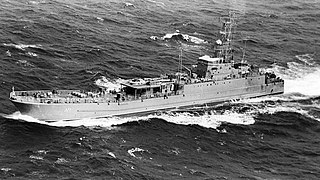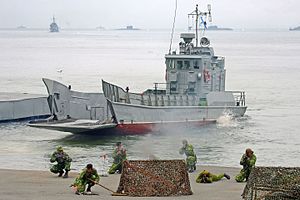
The Tarawa class is a ship class of Landing Helicopter Assault (LHA) type amphibious assault ships operated by the United States Navy (USN). Five ships were built by Ingalls Shipbuilding between 1971 and 1980; another four ships were planned, but later canceled; instead they were joined by the Wasp-class amphibious assault ships.

HMPNGS Buna is a Balikpapan-class heavy landing craft operated by the Papua New Guinea Defence Force (PNGDF). Prior to 1974, the vessel was called HMAS Buna and was operated by the Royal Australian Navy (RAN).

The Soviet designation Project 1241 Molniya are a class of Russian missile corvettes. They have the NATO reporting name Tarantul. These ships were designed to replace the Project 205M Tsunami missile cutter.

The Slava class, Soviet designation Project 1164 Atlant, is a class of guided-missile cruisers designed and constructed in the Soviet Union for the Soviet Navy, and currently operated by the Russian Navy.

A fast attack craft (FAC) is a small, fast, agile, offensive, often affordable warship armed with anti-ship missiles, gun or torpedoes. FACs are usually operated in close proximity to land as they lack both the seakeeping and all-round defensive capabilities to survive in blue water. The size of the vessel also limits the fuel, stores and water supplies. In size they are usually between 50–800 tonnes and can reach speeds of 25–50 knots (46–93 km/h).

The Chamsuri class are patrol boats originally constructed for and operated by the Republic of Korea Navy. They first entered service in 1979, and they have since seen service with five other navies, of which the Philippine Navy is currently the largest import user. These boats were built by the Korea Tacoma, and Korea SB & Eng. Masan shipyards. In Korea, the Chamsuri-class boats are being retired and replaced by Gumdoksuri-class patrol vessels.

The Bora-class, Soviet designation Project 1239, hoverborne guided-missile corvette of the Russian Navy, also bears the NATO class name "Dergach", is one of the few types of military surface effect ship built solely for marine combat purposes, rather than troop landing or transport. The first vessel produced under this designation was Sivuch, which was later renamed Bora. It is one of the largest combat sea vehicles with catamaran design.

The Zubr class, Soviet designation Project 1232.2, is a class of Soviet-designed air-cushioned landing craft (LCAC). The name "Zubr" is Russian for the European bison. This class of military hovercraft is, as of 2023 the world's largest hovercraft, with a standard full load displacement of 555 tons. The hovercraft was designed to sealift amphibious assault units from equipped/non-equipped vessels to non-equipped shores, as well as to transport and plant naval mines.

HMAS Norman, named for the Norman River in Queensland, is the third Huon-class minehunter to serve in the Royal Australian Navy (RAN). Built by a joint partnership between Australian Defence Industries (ADI) and Intermarine SpA, Norman was constructed at ADI's Newcastle shipyard, and entered service in 2000.

The Polnocny -class ships are amphibious warfare vessels. They were designed in Poland, in cooperation with the Soviet Navy and were built in Poland between 1967 and 2002. They now serve in several different navies, and some have been converted to civilian use. The name comes from the Stocznia Północna shipyard at Gdańsk, where they were built. 107 were built by 1986. In 2002, one ship of a modernised design NS-722 was built in Gdynia for Yemen.

The Poti class was the NATO reporting name for a group of anti-submarine warfare (ASW) corvettes built for the Soviet Navy. The Soviet designation was Project 204 small anti-submarine ships. These ships were the first Soviet warships powered by gas turbine engines; two propellers were mounted in tunnels to give a very shallow draught. A twin 57 mm (2 in) gun mounting provided self-defence. Three ships of the class were exported to Romania and six to Bulgaria during the Cold War. By 2008, all ships of the class were no longer extant.

The Shershen class was the NATO reporting name for a class of torpedo boats built for the Soviet Navy and allies. The Soviet designation was Project 206 Shtorm.

The Cheonghaejin class is a submarine rescue ship class of the Republic of Korea Navy. Only one ship has been built in the class, ROKS Cheonghaejin, in 1995. Its operations include rescuing trapped sailors in submarines, naval operation support for submarines, underwater research and mapping support, and recovery of sunk vessels. It is equipped with a deep submergence rescue vehicle (DSRV) that operates up to 500 metres (1,600 ft), and a rescue chamber that holds up to nine people.

The Dyugon-class landing craft, or Project 21820, is a class of five air-cavity landing craft in service with the Russian Navy.
The Khobi class is a class of replenishment oiler built for the Soviet navy between 1953 and 1958.

The Uda class, Soviet designation Project 577, is a class of replenishment oiler built for the Soviet Navy between 1962 and 1967.

Šibenik is a Končar-class missile boat in service with the Croatian Navy. It was built for the Yugoslav Navy at the Kraljevica Shipyard in the 1970s as Vlado Ćetković (RTOP-402). In 1991 during the early stages of the Croatian War of Independence it was captured by Croatian forces while being overhauled at the "Velimir Škorpik" shipyard in Šibenik.

Admiral Spiridonov was a Project 1155 Fregat Large Anti-Submarine Ship, known in the west as an Udaloy-class destroyer. The ship was named after Emil Spiridonov, a Soviet admiral who died in 1981. Launched in 1984, Admiral Spiridonov served in the Pacific Fleet with the Soviet and Russian Navies successively until being decommissioned in 2001. While in service, the vessel operated in exercises in the Sea of Japan and made good will visits to a number of Soviet allies during the latter part of the Cold War in Africa and Asia.

















